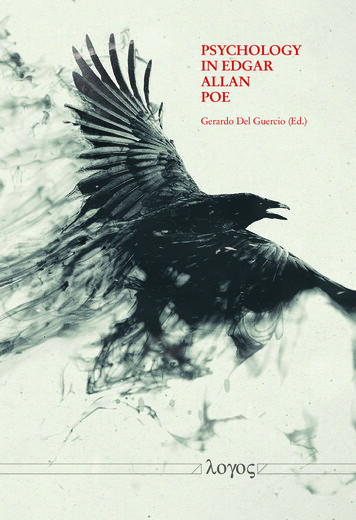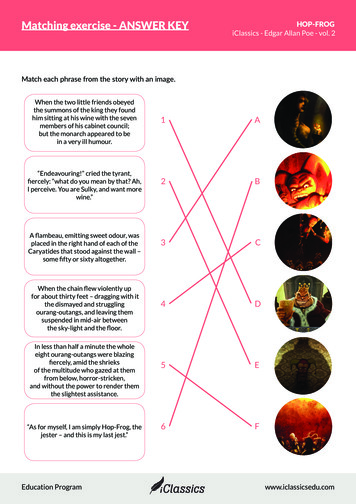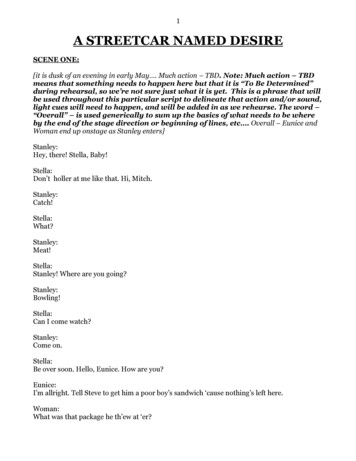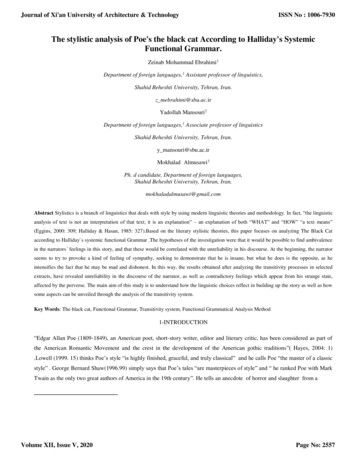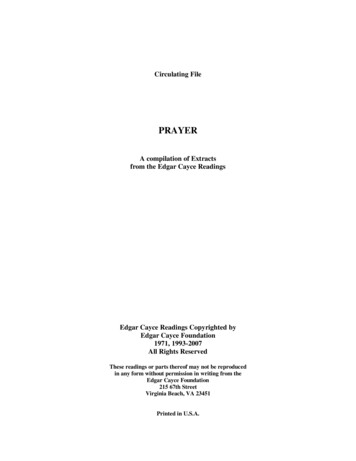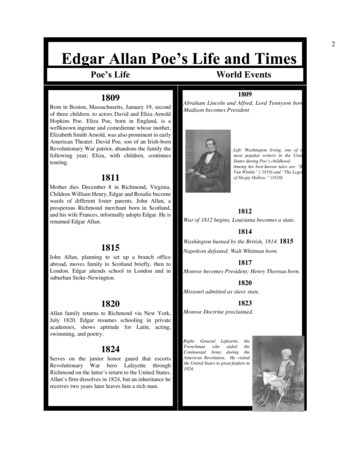
Transcription
2Edgar Allan Poe’s Life and TimesPoe’s Life1809Born in Boston, Massachusetts, January 19, secondof three children, to actors David and Eliza ArnoldHopkins Poe. Eliza Poe, born in England, is awellknown ingenue and comedienne whose mother,Elizabeth Smith Arnold, was also prominent in earlyAmerican Theater. David Poe, son of an Irish-bornRevolutionary War patriot, abandons the family thefollowing year; Eliza, with children, continuestouring.1811Mother dies December 8 in Richmond, Virginia.Children William Henry, Edgar and Rosalie becomewards of different foster parents. John Allan, aprosperous Richmond merchant born in Scotland,and his wife Frances, informally adopts Edgar. He isrenamed Edgar Allan.World Events1809Abraham Lincoln and Alfred, Lord Tennyson born;Madison becomes PresidentLeft: Washington Irving, one of themost popular writers in the UnitedStates during Poe’s childhood.Among his best-known tales are “RipVan Winkle” ( 1819) and “The Legendof Sleepy Hollow.” (1820)1812War of 1812 begins, Louisiana becomes a state.18141815John Allan, planning to set up a branch officeabroad, moves family to Scotland briefly, then toLondon. Edgar attends school in London and insuburban Stoke-Newington.Washington burned by the British, 1814. 1815Napoleon defeated; Walt Whitman born.1817Monroe becomes President; Henry Thoreau born.1820Missouri admitted as slave state.1820Allan family returns to Richmond via New York,July 1820. Edgar resumes schooling in privateacademies, shows aptitude for Latin, acting,swimming, and poetry.1824Serves on the junior honor guard that escortsRevolutionary War hero Lafayette throughRichmond on the latter’s return to the United States.Allan’s firm dissolves in 1824, but an inheritance hereceives two years later leaves him a rich man.1823Monroe Doctrine proclaimed.Right: General Lafayette, theFrenchman who aided theContinental Army during theAmerican Revolution. He visitedthe United States to great fanfare in1824.
1825Poe becomes devoted to Jane Stith Craig Stanard,mother of a schoolmate, later immortalized in Poe’slyric “To Helen.”18261825John Q. Adams becomes President.1826Deaths of Thomas Jefferson and John Adams, July4, 1826. James Fenimore Cooper publishes TheLast of the MohicansEnters the University of Virginia and distinguisheshimself in ancient and modern languages. Allowedinsufficient funds by Allan, resorts to gambling andloses 2,000. Allan refuses to back the debts, andPoe returns to Richmond to find that John Allan andthe Roysters have quashed his engagement to Elmira1827Quarrels with Allan and sails for Boston. Enlists inU.S. Army as “Edgar A. Perry” and is assigned as anartilleryman to Fort Independence in Boston Harbor.Persuades a youngprinter to issue his firstbook, Tamerlane andOther Poems (“By aBostonian”),whichgoesunreviewed.Transfers with hisartillery unit to FortMoultrie in Charleston, South Carolina.Above: The University of Virginia as it appeared in Poe’s time.1827Death of Ludwig van BeethovenLeft: Cover of Poe’s firstbook Tamerlane, publishedin 1827.Right: Poe’s drawing of ElmiraRoyster, copied by Nora Huston.Above: Poe’s room at the University of Virginia.1
1828Poe is appointed an artificer. Transfers with his unit toFort Monroe in Virginia18291828Birth of Jules Verne; construction begins onfirst American railroad.1829Andrew Jackson becomes President.Attains rank of Sergeant Major. Foster mother FrancesAllan dies February 28, 1829. Poe reconciles with JohnAllan, is honorably discharged, and seeks appointment toUnited States Military Academy at West Point. Awaitingword, lived with various Poe relatives in Baltimore andasks Allan to subsidize second volume of poems. Allanrefuses, but Al Aaraaf, Tamerlane and Minor Poems ispublished under Poe’s name in December 1829. It sellspoorly, but advance sheets of the volume receive encouraging notice.1830Enters West Point; excels in languages and lampoonsofficers in verse. John Allan remarries, severs relationswith Poe.1830Revolution forces France’s Charles X to abdicate; Emily Dickinson is born.18311831Edgar deliberately absents himself from classes and rollcalls, and is court -martialed and expelled in February1831. In New York, publishes Poems: Second Editionwith subscriptions raised from fellow cadets. Resides inBaltimore with paternal aunt, Maria Clemm, and herdaughter Virginia. Household includes paternal grandmother and Poe’s brother, William Henry, who dies oftuberculosis in August 1831. Submits five tales to Philadelphia Saturday Courier.Nat Turner leads unsuccessful slave rebellion;William Lloyd Garrison helps launch abolitionist movement.1832Lives in Baltimore in the home of his paternal grandmother. Also present are Poe’s aunt Maria Clemm andher children Virginia and Henry.1833Above: West Point in Poe’s day.1833Slavery abolished in British Empire.Submits tales and poems in Baltimore Saturday Visitorcontest; “MS. Found in a Bottle” wins first prize for besttale, and “The Coliseum” places second for poetry. Bothappear in Visitor in October 1833.1834His tale “The Visionary” appears in January 1834 issueof Godey’s Lady’s Book, a national publication. JohnAllan dies in March 1834 and leaves Poe nothing.Above: Baltimore in Poe’s day.
1835In March 1835, he begins contributing to Richmond’sSouthern Literary Messenger, which prints “The Unparalleled Adventure of One Hans Pfaall,” the first modernscience fiction story. Moves to Richmond, joins Messenger staff, and dramatically increases magazine’s circulation and national reputation. Returns to Baltimore tocourt his cousin Virginia; admonished for his drinking byMessenger proprietor Thomas W. White. Returns toRichmond with Mrs. Clemm and Virginia.1835Death of John Marshall, longest serving ChiefJustice of the Supreme Court.Right: Portrait representing Poe as hewould have appearedwhile he was workingat the Southern Literary Messenger.Above: John Marshall attended Monumental EpiscopalChurch in Richmond, which Poe and his foster parents alsoattended. Today he is best known as the Chief Justice of theUnited States Supreme Court who established the Court’suse of judicial review, the power to overrule laws it deemsviolate the Constitution.1836Marries Virginia Clemm in May, shortly before her fourteenth birthday. Moves wife and Mrs. Clemm to Richmond. As its new editor, writes book reviews, stories,and poems for Messenger, borrows money from relativesfor a boarding house to be run by Mrs. Clemm. Fails tofind publisher for his early Tales of the Folio Club, despite assistance from established authors.Left: The offices of the SouthernLiterary Messenger in Richmond,Virginia. Poe’s office was on thesecond floor of this building.1836Dickens’ Pickwick Papers published. Texasgains independence from Mexico. Ralph WaldoEmerson publishes Nature.Right: Charles Dickens, aBritish author whose worksPoe admired. Poe and Dickens would meet in Philadelphia in 1842.Left: Ralph Waldo Emerson, Transcendentalist writer who dislikedPoe’s works almost as much as Poedisliked his. Emerson derided Poefor writing poetry without a moral,and Poe called the Transcendentalists “ignoramuses.”3
1837Resigns from Messenger in January 1837. Takes family toNew York to seek employment but is unable to findeditorial post.1837” causes a depression, Mob kills Elijah P.Lovejoy, Illinois abolitionist publisher.1838Frederick Douglass escapes from slavery.1838Publishes poems and tales, including “Ligeia.” Mrs.Clemm manages a boarding house to help make ends meet.In July 1838, Harper’s publishes The Narrative of ArthurGordon Pym, Poe’s only completed novel. Moves familyto Philadelphia, continues to freelance but considersgiving up literary work.1839In financial straits, agrees to let name appear as author ofa cut-price naturalists’ manual, The Conchologist’s FirstBook. “The Fall of the House of Usher” and “WilliamWilson” appear in William Burton’s Gentleman’sMagazine. Late in 1839, Lea and Blanchard publish Talesof the Grotesque and Arabesque (two volumes).1840Poe attempts to lay groundwork for The Penn Magazine,to be under his own editorial control. Quarrels with Burtonand is dismissed from the magazine. George Rex Grahambuys The Gentleman’s Magazine, merges it with own tocreate Graham’s Magazine, to which Poe contributes “TheMan of the Crowd” for the December issue.1841Becomes editor of Graham’s Magazine; contributes “TheMurders in the Rue Morgue,” the first modern detectivestory, with new stories and poems, and articles oncryptography and autography; by year’s end, Graham’ssubscriptions more than quadruple. Inquires after aclerkship in Tyler administration. Revives plans for ThePenn Magazine.1842In January 1842, Virginia bursts a blood vessel, exhibitssigns of tuberculosis. Poe meets Dickens. Publishes “TheMasque of the Red Death” and the short story-definingreview of Hawthorne’s Twice Told Tales. Resigns fromGraham’s in May 1842 and is succeeded by Rufus WilmotGriswold (later Poe’s literary executor). Fall publicationsinclude “The Pit and the Pendulum.”1837Victoria becomes queen of Great Britain;Van Buren becomes President of UnitedStates; Michigan joins Union, “Panic ofRight:NathanielHawthorne, author of TheScarlet Letter (1850) andTwice-Told Tales (1837),was one of the fewAmerican authors Poeadmired.1840“Log Cabin and Hard Cider” campaign of1840; William Henry Harrison elected president.1841President Harrison dies one month afterinauguration, April 1841; John Tyler becomesPresident.1842“Great Migration” to Oregon begins.
71843Contributes “The Tell-Tale Heart,” “Lenore,” and an essaylater titled “The Rationale of Verse” to James RussellLowell’s short-lived magazine The Pioneer. Goes toWashington D.C. to be interviewed for minor post in Tyleradministration and to solicit subscriptions for his ownjournal, retitled The Stylus; gets drunk and ruins hischances for the job. Resumes writing satires, poems andreviews but is pressed to borrow money from Griswoldand Lowell. “The Gold Bug” wins 100 prize innewspaper contest and is reprinted widely, thendramatized on the Philadelphia stage, making Poe famousas a popular writer. The first and only number of apamphlet series, The Prose Romances of Edgar A. Poe,appears in July and includes “The Murders in the RueMorgue.” Enters the lecture circuit with “The Poets andPoetry of America.” Fall publication of “The Black Cat.”1844Moves family to New York, creates a sensation withnewspaper publication of “The Balloon Hoax,” whichpurports a transatlantic crossing by air. Works onnevercompleted Critical History of American Literatureand contributes articles on the literary scene and the lackof international copyright law.Right: Poe in 1845 from anengraving published in Graham’sMagazine in 1845.1845Poe’s “miracle year.” “The Raven” appears in the JanuaryEvening Mirror and creates a national sensation; Poeenters New York literary society. Graham’s publishesPoe’s portrait with a laudatory profile by Lowell, Wileyand Putnam publishes Poe’s Tales, then The Raven andOther Poems. Borrows money from Griswold, Greeley,and others to acquire controlling interest in The BroadwayJournal. Conducts literary courtship in verse with poetFrances Sargent Osgood. Initiates the “Little LongfellowWar,” a private campaign against plagiarism, withLongfellow the most eminent of those accused. Campaignbrings notoriety and alienates friends such as Lowell.Negative publicity from his reading at the Boston Lyceum,and the insulting jibes against Boston with which Poeresponds, further damage his reputation and increase hisfame. In the fall, Virginia Poe’s illness becomes acute.1843Elizabeth Barrett Browning publishes Poems.Right: Poe as he appeared in1843.1844Democratic convention calls for the annexationof Texas and acquisition of Oregon; Samuel F. B.Morse demonstrates the telegraph.Right: Circa1846illustration for “TheRaven” by British artistDante Gabriel Rossetti. In1848, Rossetti became afounder of the PreRaphaelite Brotherhood ofartists.1845Polk becomes President; Congress adopts jointresolution to annex Texas; Florida enters theUnion; Frederick Douglass publishes Narrativeof the Life of Frederick Douglass.Left: Title page for Poe’s The Ravenand Other Poems (1845) the poet’s finaland best-known collection of poetry.The book is dedicated to ElizabethBarrett Browning. It was reprinted thefollowing year in London, where itearned Poe more European admirers.5
1846Illness, nervous depression, and hardship force Poe to stoppublication of The Broadway Journal. Moves family tocottage in Fordham, New York, where Virginia, now asemi-invalid, is nursed by family friend Marie LouiseShew. Poe and family mentioned as pitiable charity casesin the New York press. Poe manages to publish “The Caskof Amontillado,” “The Philosophy of Composition,” bookreviews, and “Marginalia” in various magazines. Beginsseries of satirical sketches of “The Literati of New YorkCity” in Godey’s. The one on Thomas Dunn English,whom Poe had known in Philadelphia, draws a viciousattack by English on Poe’s morality and sanity. Poe suesThe Evening Mirror, publisher of the piece, and collectsdamages the following year. Hears rumors of his nascentfame in France, where translations and a long analysis ofTales appear.1846Failure of potato crop causes famine in Ireland.United States declares war on Mexico; annexesNew Mexico and California; Herman Melvillepublishes Typee.Right:HermanMelville, author ofMoby Dick, which somePoe scholars claim wasinfluenced by Poe’snovel The Narrative ofArthur Gordon Pym.Right: Poe as he appeared in 1846.Left: Henry WadsworthLongfellow, writer ofsuch poems as The Songof Hiawatha (1855) andPaulRevere’sRide(1861). Poe consideredhimunoriginalandthought his high literaryreputation was the resultof his personal contacts.1847Virginia Poe dies of tuberculosis January 30. Poe fallsgravely ill. Nursed back to health by Mrs. Clemm and Mrs.Shew, once more seeks support for literary magazine andfails again. Completes revised versions of Hawthornereview and “The Landscape Garden” and writes“Ulalume.” Increasing interest in cosmological theoriesleads to preliminary notes for Eureka.1848Begins year in better health. Gives lectures and readings toraise capital for The Stylus. February lecture on “TheUniverse” in New York surveys thematic materialelaborated in Eureka, published by Putnam in June. Whilelecturing in Lowell, Massachusetts, forms deep attachmentto “Annie” (Mrs. Nancy Richmond), who becomes1847Mormons establish Salt Lake City; HenryWadsworth Longfellow publishes Evangeline.1848Revolutions throughout Europe; Marx andEngels publish The Communist Manifesto. Golddiscovered in California.6
his confidante; subsequently, in Providence, Rhode Island, begins three -month courtship of widowed poetSarah Helen Whitman, to whom he proposes marriage.When she delays answering him because of reports of his“unprincipled” character, Poe provokes a crisis, and their brief engagement is broken off.Reads “The Poetic Principle” as lecture to anaudience of 1,800 inProvidence. Writes “TheBells.”Right:Photograph of Poetaken in Providence, RhodeIsland in 1848.Above: Poster drawing people west for California gold.18491849Death of Chopin. California gold rush begins.Active as writer and lecturer. In June, leaves for Richmond to seek Southern support for The Stylus. Stops inPhiladelphia, sick, confused and apparently sufferingfrom persecution mania. Friends care for him and seehim off to Richmond. Recovers during two -month stay inRichmond, visits sister Rosalie, joins temperance society,and becomes engaged to boyhood sweetheart ElmiraRoyster Shelton, now a widow. Possibly intending tobring Mrs. Clemm to Richmond from New York, sailsfor Baltimore where, a week after arrival, he is foundsemiconscious and delirious outside a tavern and pollingplace on October 3. Dies October 7. “The Bells” and“AnnabelLee”appearposthumously late in theyear. Slanderousobituary notice byGriswold blackensPoe’s reputation formany years.Right: Elmira RoysterSheltonLeft: The last photograph of Poe, takenSeptember 1849 in Richmond, Virginia.Compiled by Norman George, Courtesy G.R. Thompson7
Poe’s FamilyPoe’s MotherElizabeth Arnold Poe 1787-1811The British-born actress Elizabeth Poe was a popular performer in theatersfrom Boston to Charleston. She died when Edgar was only two years oldand is buried Saint John’s Church in Richmond, Virginia.Poe’s FatherDavid Poe, Jr.1784-1811?Poe’s father was also an actor. His last known performance was held inNew York in 1809. His whereabouts are unknown after he left his wifesometime before July 1811. No portrait of him is known to exist.Poe’s BrotherWilliam Henry L. Poe 1807-1831As an infant Edgar’s older brother, known as Henry, was taken in by hisgrandparents in Baltimore. Henry published a few poems during his brief life.No portrait of him exists.Poe’s SisterRosalie Poe 1810-1874When Edgar’s mother died, he was taken in by the Allans while hissister went to live with the Mackenzie family of Richmond. Rosalienever married. After the Civil War, the Mackenzies could no longercare for Rosalie, and she died in a charity home.11
The AllansPoe’s Foster FatherJohn Allan 1779-1834The Scottish-born tobacco merchant Allan took in the orphaned Edgarwithout ever legally adopting him or including Poe in his will. In a letter,Allan once referred to Poe as “quite miserable, sulky & ill-tempered to allthe Family.” The Allans are buried at Shockoe Cemetery in Richmond,Virginia.Poe’s Foster MotherFrances Allan 1785-1829Frances Allan was one of the Richmond ladies who, in response to anadvertisement in the local paper, brought Poe’s mother meals during her finalillness. After Mrs. Poe’s death, Mrs. Allan took Edgar into her home. Shehad no other children and treated Edgar as her own. Mrs. Allan died oftuberculosis while Poe was serving in the army at Fort Monroe, Virginia. Hereturned to Richmond a day late for her funeral.John Allan’s Second WifeLouisa Allan 1800-1881After the death of Frances Allan in 1829, JohnAllan married on October 5, 1830 in New York. Poe was at West Point anddid not know about the wedding until after the fact. Allan and his secondwife soon had three sons who became the heirs to the Allan fortune.The Allans’ Homes in RichmondAll the homes in which Poe lived with the Allans have all been demolished. The photos below show some of thesehouses and the dates in which Poe lived in them.Second and Franklin Streets, 1820Fourteenth Street, 1822-1825 Fifth and Main Streets, 1825-182712
Home Life of PoePoe’s Mother-in-LawMaria Poe Clemm 1790-1871The sister of Edgar Poe’s father, Maria Clemm also became Poe’smother -in-law when he married her daughter Virginia. Poe soughtrefuge in her Baltimore home in early 1831 after his expulsion fromWest Point. Already living with her were Edgar’s brother WilliamHenry Leonard Poe (who would die of tuberculosis later that year), hisgrandmother Mrs. David Poe, Maria’s son Henry, and her daughterVirginia. Mrs. Clemm had lost her husband five years earlier.“Muddy,” as Poe called her, cared for the household while Poe soughtemployment. In 1835, Poe was hired as assistant editor of the SouthernLiterary Messenger and returned to Richmond. After the deaths ofWilliam Henry Leonard Poe, Mrs. David Poe, and Henry Clemm, EdgarPoe brought Maria and Virginiawith him to Richmond.Poe’s WifeVirginia Clemm Poe 1822-1847Edgar’s cousin Virginia Clemm and her mother Maria Clemm moved toRichmond in 1836. On May 16, 1836, a marriage bond was signed betweenEdgar and Virginia. She was thirteen years old, and Poe still referred to heras “Sissy.” At first, their marriage was a happy one. A friend of the Poes,Francis Osgood described Virginia as Edgar Poe’s “young, gentle, andidolized wife” and stated, “I believe she is the only woman he ever trulyloved.” Another friend, Mrs. Mary Grove wrote of Virginia, “Her pale face,her brilliant eyes, and her raven hair gave her an unearthly look.” WhenVirginia was nineteen, she began to show signs of tuberculosis, of which shewould die at the age of twenty four, the same age at which Edgar Poe’s mother and brother had died.Left: The home in which Poe’s wife died in Fordham (now TheBronx), New York. When Poe left Manhattan in 1846, he movedwith his dying wife and his mother-in-law to this humble cottage inthe countryside fourteen miles outside the city. Mrs. Mary Gove, avisitor to the cottage described it as “a little cottage at the top of ahill The house had three rooms—a kitchen, a sitting-room, and abed chamber over the sitting room.The cottage had a air of tasteand gentility that must have been lent to it by the presence of itsinmates. So neat, so poor, so unfurnished, and yet so charming adwelling I never saw.” When Poe left on his lecture tours after thedeath of his wife, his mother-in-law remained in the cottage. Itwas here that she learned of his death from the newspapers.
Common Poe MythsMuch of what we think we know about Poe is wrong. In fact, many erroneous details are still includedin text books to this day. Below are some common Poe myths:He was an opium addict.Poe’s enemy Thomas Dunn English once wrote: “Had Poe the opium habit when I knew him Ishould both as a physician and a man of observation, have discovered it during his frequent visits tomy rooms, my visits at his house, and our meetings elsewhere—I saw no signs of it and believe thecharge to be a baseless slander.” English is the man Poe sued for libel so English would certainly nothave defended the poet’s reputation out of loyalty.Poe wrote under the influence of opium or alcohol.Given the above statement as well as the fact that excessive alcohol consumption left Poe bedriddenfor days at a time, he does not seem to have written while under the influence of drugs. His mannerof composition is methodical, and his handwriting is meticulous even in his rough drafts. Theseobservations would lead one to believe that he did not write in the heat of passion but in a morecalculated manner. Although his essay “The Philosophy of Composition” is generally viewed asexaggerating the methodical nature of his composition of “The Raven,” the essay does still give usinsight into the approach to writing that Poe valued and hoped to emulate. Mrs. Osgood, a frequentvisitor to the Poe home described Poe sitting “hour after hour, patient, assiduous and uncomplaining”as he wrote.He was expelled from the University of Virginia.He was not allowed to return because he had not paid all his expenses from the first semester.He was expelled from West Point for attending drill in the nude.Although Poe was expelled from West Point, the nudity legend has its origins in the 1920’s, andreferences to it from Poe’s time cannot be found. Poe was actually charged with “Gross Neglect ofDuty” for “absenting himself from parades and roll calls, between the 15th and 27th of January 1831”as well as for “Disobedience of Orders” for refusing to attend church after having been directed to doso by an officer on January 23, 1831 and for another direct defiance of orders on January 25. Poepleaded “not guilty” to the first charge and “guilty” to the remaining charges but was found guilty onall charges. In this excerpt from Poe’s January 3, 1830 letter to John Allan, Poe explains why hefeels he must leave West Point and threatens to get himself expelled if Allan will not allow him toresign.
Poe died drunk in a gutter.He actually died in Washington College Hospital. His attending physician was John Moran.Unfortunately, Poe’s medical records do not survive. In a letter Moran wrote to Maria Clemm onNovember 15, 1849, Moran did not say the cause of Poe’s death but cryptically stated “you arealready aware of the malady of which Mr. Poe died.” The newspapers in the days immediatelyfollowing his death described his condition as “an attack of mania a potu” (drunkenness),“congestion of the brain,” and a chronic condition from which Poe had been suffering “for someyears past.” Most of the confusion about Poe’s cause of death derives from two feuding camps ofPoe biographers. On one side Poe’senemies Griswold, Snodgrass, andStoddard used Poe’s death as a moralitytale to demonstrate the evils of alcohol.They portrayed Poe as a drunk who diedafter a drinking binge. On the other side,Poe’s defenders Moran, Elizabeth OakesSmith, and John R. Thompson came upwith alternative theories to explain Poe’sdeath without portraying Poe as a drinker,which would have been considered amoral weakness. The latter groupperpetuated theories that Poe had beenbeaten or drugged. Both campsBelow are a few theories about Poe’s death and dates they were published.1857 Beating1860s Cooping1874 Epilepsy1921 Dipsomania1926 Heart1970 Toxic Disorder1970 Hypoglycemia1977 Diabetes1984 Alcohol Dehydrogenase Deficiency1989 Porphyria1992 Delirium Tremens1996 Rabies1997 Heart1998 Murder (Beating)1999 Epilepsy1999 Carbon Monoxide PoisoningSource:Poe Museum (Richmond Virginia) Educator Packet
Edgar Allan Poe’s Life and Times Poe’s Life World Events 1809 Born in Boston, Massachusetts, January 19, second of three children, to actors David and Eliza Arnold Hopkins Poe. Eliza Poe, born in England, is a wellknown ingenue and comedienne whose mother, Elizabeth Sm

